|
During the Cold War the Typhoon submarines
prowled the waters of the North Atlantic. These submarines
do not have to submerge or go to sea to launch their
long-range missiles. They are able to do so tied up
at their docks. The Typhoon is the world’s largest
submarine and was one of the most feared weapons of
the Cold War. Each submarine is capable of carrying
twenty long-range ballistic missiles with up to 200
nuclear warheads that were once aimed at the United
States.
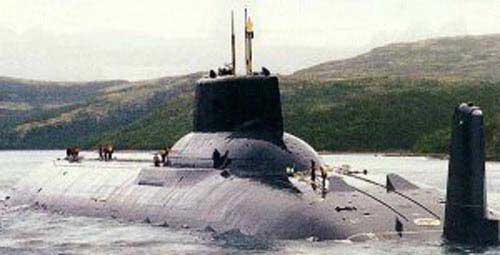
The design of the Typhoon submarine
is multi-hulled and bears resemblance to a catamaran.
The submarine has two separate pressure hulls with a
diameter of 7.2 m each, five inner habitable hulls and
19 compartments. The pressure hulls are arranged parallel
to each other and symmetrical to a centerplane. The
missile compartment is arranged in the upper part of
the bow between the pressure hulls. Both hulls and all
compartments are connected by transitions. The pressure
hulls, the centerplane and the torpedo compartment are
made of titanium and the outer light hull is made of
steel. A protected module, comprising the main control
room and electronic equipment compartment, is arranged
behind the missile silos above the main hulls in a centerplane
under the guard of retractable devices.
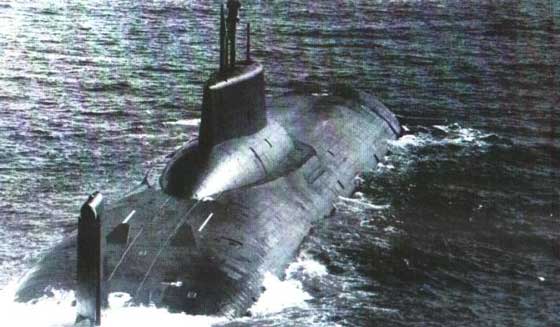
The submarine's design includes features
to enable it to both travel under ice and for ice-breaking.
It has an advanced stern fin with horizontal hydroplane
fitted after the screws. The nose horizontal hydroplanes
are in the bow section and are retractable into the
hull. The retractable systems include two periscopes
(one for the commander and one for general use), radio
sextant, radar, radio communications, navigation and
direction-finder masts. They are housed within the sail
guard. The sail and sail guard have a reinforced rounded
cover for ice-breaking.
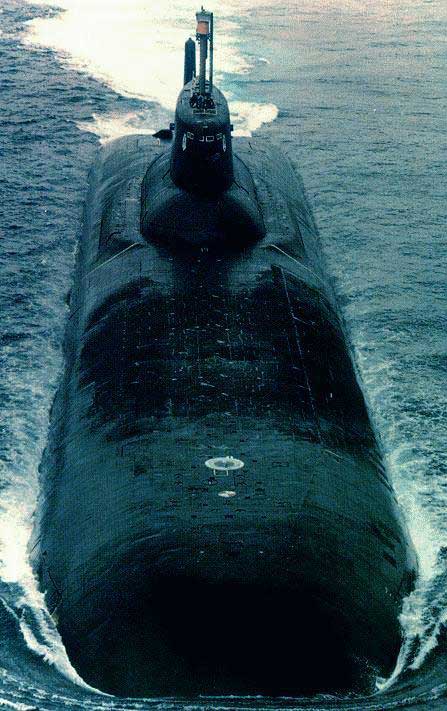
The submarine is equipped with the D-19
launch system with 20 solid-fuel propellant R-39 missiles
which have a range of up to 10,000 km. They are arranged
in silos in two rows in front of the sail between the
main hulls. The Typhoon has an automated torpedo and
missile loading system including 6 torpedo tubes with
calibres of 650 and 533 mm.
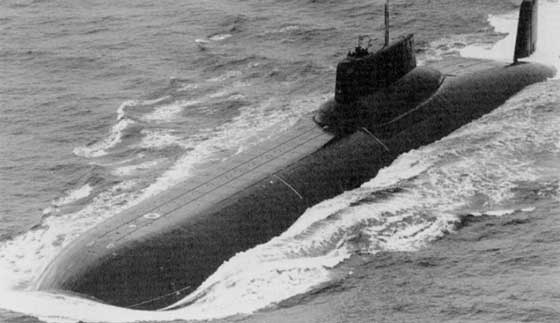
The main machinery consists of two reactors
each and two steam turbines of 190 MW that provide a
maximum speed of 25-27 knots. Compared to the first
and second generation of SSBNs the Typhoon enjoys far
greater maneuverability Despite of its larger displacement
the Typhoons are less noisy than their predecessors.
To reduce the acoustic signature a two-spool system
of rubber-cord pneumatic shock-absorption is employed
as well as a block layout of gears and equipment, a
new sound isolation and andrihydroacoustic coating.
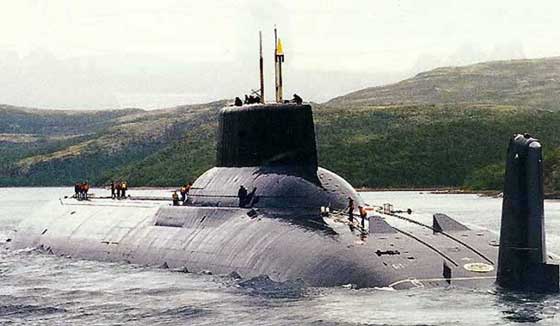
The Typhoons are equipped with the "Slope"
hydroacoustic system that consists of four hydroacoustic
stations. The "Slope" system allows to track
10-12 vessels simultaneously. It also employs two floating
antenna buoys to receive radio messages, target designation
data and satellite navigation signals at great depth
and under an ice cover.
The development of the 941 heavy strategic
submarine was authorized in December 1972, and on 19
December 1973 the governmental officially issued the
order to design and build the 941 ballistic missile
submarine. The developer was the Leningrad design bureau
which is now the Central Design Bureau for Marine Engineering
"Rubin". After intensive testing the heavy
ballistic missile submarine 941-"TK-208" was
commissioned in September 1980 and introduced into the
Northern fleet on 12 December 1981. Between 1981 and
1989 six Typhoon submarines entered service. They formed
part of the 1st flotilla of atomic submarines based
in the Western Theater of the Northern fleet based at
Nyerpichya. A seventh vessel was begun but never finished.
The Typhoon submarines were initially
intended to be retrofitted with a replacement of the
D-19 launch system with an advanced system, and the
new SS-N-28 missile. The lead unit of this class, the
TK-208, had been in overhaul since 1992 with the intent
of receiving these modifications, but it now appears
that it will not return to service. All but one of the
Typhoon class submarines are slated to be withdrawn
from service within a few years, and it is unlikely
that units of the class would be modified to accomodate
new missiles.
In 1997 two Typhoon submarines were
decommissioned. The operational lifetime of these submarines
is estimated to be 20-30 years, though in order to operate
a ship for this period requires that a major overhaul
be performed every 7-8 years. Otherwise, a submarine's
service life shrinks to 10-15 years. Navy officials
claim that it is possible to extend operations of the
Typhoons until 2005-2007.
The Nunn-Lugar Cooperative Threat Reduction
program is scheduled to dismantle 25 Delta-class, as
many as five Typhoon-class, and one Yankee-class ballistic
missile submarines capable of launching over 400 missiles
with over 1,700 warheads, by the year 2003. In 1999
Secretary of Defense Bill Cohen approved the contract
to begin dismantlement of the first Typhoon nuclear
submarine. If and when all of these submarines are dismantled,
1,200 nuclear weapons will be removed from operational
systems.
As of June 2000 the Russian Navy claimed
that it operates 26 strategic nuclear submarines carrying
2,272 nuclear warheads on 440 ballistic missiles. This
force was said to consist of 5 Typhoon class submarines,
7 Delta-IV class submarines, and 13 Delta-III class
submarines [which only adds up to 25, not 26 submarines].
Not all of these submarines are presently seaworthy.
According to one published report as of 1999 only a
single Typhoon remained operational [probably TK-20],
and most estimates would suggest that no more than three
boats were in service by early 2000.
In January 2000 it was reported that
three of six Russian Typhoon-class submarines would
remain in active operation to test the new Bark-class
strategic missiles, contrary to both the plans of the
Co-operative Threat Reduction program and reports that
Bark-class missiles had been cancelled due to design
failures. The Russian Navy reportedly believes that
12 strategic nuclear submarines with ballistic missiles
represent the minimum necessary force structure. According
to media reports a classified presidential decree of
04 March 2000 established this force goal for the period
through 2010. |